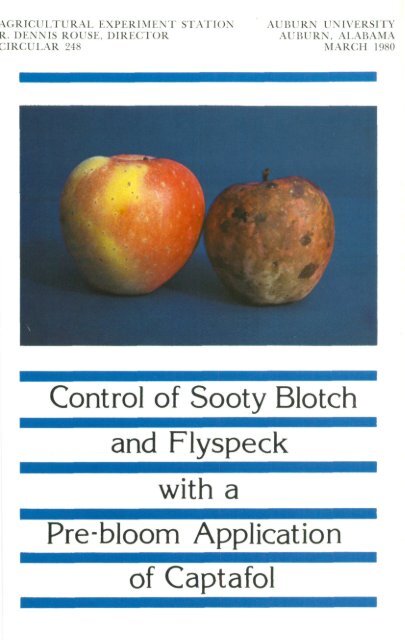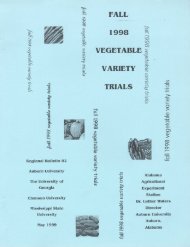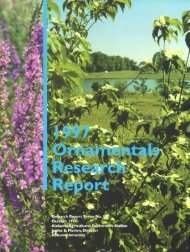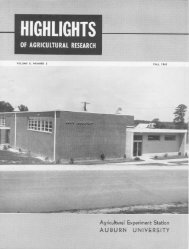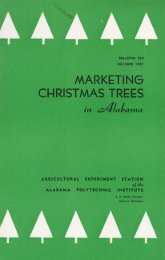Control of Sooty Blotch and Flyspeck - Auburn University Repository
Control of Sooty Blotch and Flyspeck - Auburn University Repository
Control of Sooty Blotch and Flyspeck - Auburn University Repository
You also want an ePaper? Increase the reach of your titles
YUMPU automatically turns print PDFs into web optimized ePapers that Google loves.
IR11(J,1,I :K ?IS<br />
R. I)1I MSN I: Ol SI. I)II( F I OK<br />
\I1 RN 1'\I'IK SI I Il<br />
\1'UR . U \I1\ 198<br />
<strong>Control</strong> <strong>of</strong> <strong>Sooty</strong> <strong>Blotch</strong><br />
<strong>and</strong> <strong>Flyspeck</strong><br />
with a<br />
Pre-bloom Application<br />
<strong>of</strong> Captafol
SUMMARY<br />
<strong>Sooty</strong> blotch <strong>and</strong> flyspeck diseases occurred on apples that developed<br />
from h<strong>and</strong> pollinated blossoms covered with plastic bags<br />
in 1974. Trace amounts <strong>of</strong> the diseases developed on apples<br />
sprayed with captafol at delayed dormant, pre-pink, <strong>and</strong> petal fall<br />
stages <strong>of</strong> development in 1975, whereas unsprayed apples covered<br />
at the same time developed twice as much sooty blotch <strong>and</strong> three<br />
times as much flyspeck. With applications <strong>of</strong> captafol at pre-pink<br />
<strong>and</strong> near full-bloom in 1976, sooty blotch <strong>and</strong> flyspeck ratings<br />
were less than 2. During 1978, when captafol was applied at green<br />
tip <strong>and</strong> metiram was used throughout the cover sprays, sooty<br />
blotch <strong>and</strong> flyspeck incidence was 1.01 <strong>and</strong> 0.16, respectively.<br />
COVER PHOTO. Red Delicious apple infected with sooty blotch <strong>and</strong> flyspeck<br />
(right) <strong>and</strong> clean apple (left). Solid greenish-black blotches are typical <strong>of</strong> sooty<br />
blotch disease <strong>and</strong> pin point spots are typical <strong>of</strong> flyspeck disease.<br />
Information contained in this publication is available to all persons<br />
regardless <strong>of</strong> race, color, or national origin.<br />
FIRST PRINTING 4M-MARCH 1980
<strong>Control</strong> <strong>of</strong><br />
<strong>Sooty</strong> <strong>Blotch</strong> <strong>and</strong> <strong>Flyspeck</strong> <strong>of</strong> Apples<br />
with a<br />
Pre-bloom Application <strong>of</strong> Captafol<br />
A. J. LATHAM AND M. H. HOLLINGSWORTH1<br />
SOOTY BLOTCH AND FLYSPECK are problem diseases on apples<br />
grown in humid areas such as Alabama. Symptoms <strong>of</strong> these diseases<br />
have been found on July Red Delicious <strong>and</strong> Transparent<br />
apples as early as mid-June (1). Besides causing an unappealing<br />
fruit appearance, a high incidence <strong>of</strong> these diseases has caused<br />
apples to fall 3 weeks earlier than disease-free fruit on adjacent<br />
trees <strong>of</strong> Richared Red Delicious apples (9). <strong>Sooty</strong> blotch is caused<br />
by Gloeodes pomigena (Schw.) Colby <strong>and</strong> flyspeck is caused by<br />
Zygophiala jamaicensis Mason.<br />
Ascospores <strong>of</strong> Z. jamaicensis were discharged in April in coastal<br />
California during <strong>and</strong> following the apple blossom season (4). In<br />
Indiana, mature ascospores <strong>of</strong> Z. jamaicensis were found during<br />
the first part <strong>of</strong> June (1), <strong>and</strong> those <strong>of</strong> G. pomigena in late May<br />
<strong>and</strong> early June (2). First infections by these fungi occurred before<br />
June 21 (6) or within a month <strong>of</strong> petal fall (8) in Pennsylvania.<br />
The spores are airborne for considerable distance, <strong>and</strong> initiate primary<br />
infections on newly developed plant parts (3). Five to 15<br />
days are required for symptoms to develop on apples under cool,<br />
moist conditions (6,14). Growth <strong>of</strong> Z. jamaicensis occurred over<br />
a temperature range <strong>of</strong> 40-80°F (1). Similar moisture <strong>and</strong> temperature<br />
condilions are required for infection by G. pomigena,<br />
which explains the association <strong>of</strong> these fungi (13).<br />
Generally, recommended spray schedules in apple-growing areas<br />
call for fungicide control <strong>of</strong> sooty blotch <strong>and</strong> flyspeck to start with<br />
1Associate Pr<strong>of</strong>essor, Department <strong>of</strong> Botany, Plant Pathology, <strong>and</strong> Microbiology,<br />
<strong>and</strong> Superintendent, North Alabama Horticulture Substation, respectively.
A ,<br />
Appearance <strong>of</strong> this apple with its many pin point spots is typical <strong>of</strong> fruit infected<br />
with sooty blotch disease.<br />
the second (11,12) to fourth (7,13) cov er spray, <strong>and</strong> continue un<br />
til harx est. Timing fungicide applications according to such<br />
schedules does not appear to coincide 'a ith development <strong>of</strong> the<br />
diseases in Alabama. Both fungi are activ e during humid, cool<br />
spring weather, but may be entirely albsent during hot, dry, sum<br />
iner weather (2). In Alabama, control <strong>of</strong> sooty blotch <strong>and</strong> flyspeck<br />
was poor with a dodiiie + ferlbani Ilossom spr ay followed by<br />
folpet cover sprays, or a season long aplplication <strong>of</strong> metiram,<br />
mancozeb + dinocap, thiram + folpet, dithianon, or with thiophanate<br />
methyl (9).<br />
The purpose <strong>of</strong> this investigation was to obtain effective control<br />
<strong>of</strong> sooty blotch <strong>and</strong> flyspeck on apples by improving the<br />
tining <strong>of</strong> fungicidal appjlications in Alabama.<br />
MATERIALS AND METHODS<br />
In 197 1, the seasonal development <strong>of</strong> sooty blotclh <strong>and</strong> flyspeck<br />
was investigated on imature Richared Red l)elicious apples at the<br />
North labanma llorticutilture Substation, Cullman. A 1-quart<br />
plastic bag was placed over apple blossolls or fruit clusters, with<br />
only a few attached leaves included, <strong>and</strong> tied to tihe twig. Tile<br />
lbag was cut i inch deep) at righlt angles to te bottom, to release<br />
wvater condlensate. On \April 9, 15, <strong>and</strong> 23, a total <strong>of</strong> 260 blossoms<br />
was b~agged on each <strong>of</strong> six trees. Tile Ilossoms had browned<br />
stamens <strong>and</strong> pistils, indicating pollination polobably had occuired.<br />
Bagging continued on April 30 <strong>and</strong> Mlay 7, with 60 ap~ple clusters
agged on each <strong>of</strong> six trees; average diameter <strong>of</strong> the apples on the<br />
two dates was 3/ <strong>and</strong> 5/ inch, respectively. Fruit set occurred between<br />
April 9 <strong>and</strong> 15. On August 15, all bagged apples <strong>and</strong> nonbagged<br />
check fruit were harvested for disease determinations.<br />
Incidence <strong>of</strong> sooty blotch <strong>and</strong> flyspeck on each apple was rated on<br />
a 0 to 5 scale, where 0 = no disease, 1 = trace, 2 = 2-10 percent,<br />
3 = 11-25 percent, 4 = 25-50 percent, 5 = 51 to 100 percent <strong>of</strong><br />
fruit surface diseased.<br />
In 1975 benomyl 2 (0.5 pound per 100 gallons <strong>of</strong> water plus<br />
1 quart non-phytotoxic oil) <strong>and</strong> captafol 3 (5 quarts per 100 gallons<br />
plus 1 quart non-phytotoxic oil) were applied at silver tip (March<br />
26), tight cluster (April 11), <strong>and</strong> petal fall (May 1) stages <strong>of</strong> growth<br />
on Red Delicious apples. The fungicides were applied separately<br />
by h<strong>and</strong> gun as dilute sprays to run-<strong>of</strong>f, using a John Bean sprayer<br />
at 400 p.s.i. to six single-tree replicates. Six unsprayed trees served<br />
as checks. No oil was used with captafol on April 11 or May 1.<br />
On May 9, all trees were sprayed with Guthion 50W <strong>and</strong> Cygon<br />
267 EC for insect control. No other sprays were applied during<br />
the season. Subsequently, Golden Delicious apple pollen (Antles'<br />
Pollen Supplies, Wenatchee, Wash.) was applied to stigmas <strong>of</strong><br />
blossoms on sprayed <strong>and</strong> unsprayed trees with a camel hair brush<br />
<strong>and</strong> the blossoms were covered with plastic bags. On April 15, 17,<br />
<strong>and</strong> 21, twenty-five h<strong>and</strong> pollinated blossoms or clusters <strong>of</strong> blossoms<br />
were bagged per tree. Similarly, on April 24, May 1, <strong>and</strong><br />
May 8, twenty-five developing apples or apple clusters that were<br />
naturally pollinated were bagged per tree. The average diameter<br />
<strong>of</strong> 60 apples from six trees was 7/ inch on May 8. On August 5,<br />
all bagged <strong>and</strong> 25 nonbagged fruit per tree were harvested <strong>and</strong><br />
disease evaluations made.<br />
In 1976, captafol (5 quarts per 100 gallons water plus 1 quart<br />
non-phytotoxic oil) was applied to 12 trees in the pink stage (April<br />
1) <strong>and</strong> near full bloom (April 7). Six trees received no additional<br />
fungicide applications; the other six were sprayed with metiram 4<br />
(2 pounds per 100 gallons water). Fungicide <strong>and</strong> insecticide applications<br />
were made on April 19 <strong>and</strong> 26, May 3, 10, 17, <strong>and</strong> 24,<br />
June 1, 8, 16, 21, <strong>and</strong> 29, <strong>and</strong> July 6, 17, <strong>and</strong> 30. Six trees were<br />
left unsprayed to serve as controls. Apples were harvested on August<br />
8 <strong>and</strong> disease evaluations were made from 1 bushel <strong>of</strong> apples<br />
r<strong>and</strong>omly selected from each tree.<br />
2Benlate 50WP.<br />
aDifolatan 4F.<br />
4Polyram 80WP.<br />
[5]
During 1978, captafol (1976 rate) was applied in the green tip<br />
stage (April 3) <strong>and</strong>, subsequently, metiram (to five trees) was applied<br />
at 1976 rates on April 17 <strong>and</strong> 24, May 2, 9, 19, <strong>and</strong> 28, June<br />
9 <strong>and</strong> 23, July 7 <strong>and</strong> 21, <strong>and</strong> August 4 <strong>and</strong> 18. Dodine 5 (0.5 pound<br />
per 100 gallons water) was applied during bloom (April 10), followed<br />
by metiram cover sprays. Five trees were left unsprayed to<br />
serve as controls; however, fruit had rotted or dropped from two<br />
<strong>of</strong> these trees by harvest on August 29. One bushel <strong>of</strong> apples r<strong>and</strong>omly<br />
selected from each tree was evaluated for diseases.<br />
RESULTS<br />
Observations in 1974 indicated that the source <strong>of</strong> infection by<br />
the sooty blotch fungus might have been inoculum on twigs or<br />
leaves within the bags. <strong>Sooty</strong> blotch was most prominent in the<br />
stem depression <strong>of</strong> the fruit. Other sites <strong>of</strong> extensive infection<br />
were the blossom ends <strong>and</strong> areas adjacent to where leaves were in<br />
contact with the fruit. <strong>Sooty</strong> blotch developed where plastic bags<br />
were in contact with an apple, if the area was wet. Parts <strong>of</strong> apples<br />
submerged in condensate showed extensive sooty blotch.<br />
From the data,, it appeared that inoculum <strong>of</strong> Z. jamaicensis was<br />
not abundant on twigs at the time blossoms or apples were bagged,<br />
table 1. In addition to these data, 44 apples showing bitter rot,<br />
black rot, white rot, or other rots too extensive to permit evaluations<br />
for sooty blotch <strong>and</strong> flyspeck were also collected from the<br />
bags.<br />
Evaluations <strong>of</strong> sooty blotch <strong>and</strong> flyspeck development in 1975<br />
showed index ratings less than 2 on apples bagged during the<br />
TABLE 1. INCIDENCE OF SooTY BLOTCH AND FLYSPECK AT HARVEST ON APPLES<br />
ENCLOSED IN PLASTIC BAGS AT VARIOUS STAGES OF GROWTH DURING 19741<br />
Dates baggedApple Disease indices2 Apples<br />
Dates bagged growth <strong>Sooty</strong> blotch <strong>Flyspeck</strong> harvested<br />
April 9, 15, 23 Bloom 1.9 0.2 913<br />
April 30 3/ inch diameter 1.5 .7 40<br />
May 7 5/ inch diameter 1.9 .7 29<br />
August 15<br />
(control) not bagged 4.7 2.9 38<br />
i1Data are averages from apples harvested from six trees on August 15.<br />
2Disease severity scale: 0 - no disease, I -= trace, 2 = 2-10 percent, 3 = 11-25<br />
percent, 4 = 26-50 percent, 5 = 51-100 percent <strong>of</strong> fruit surface diseased.<br />
3Number <strong>of</strong> apples harvested per treatment; rotted apples were not included in<br />
totals.<br />
5Cyprex 65WP.<br />
[6]
lossoming period. Apparently, benomyl gave no disease control,<br />
since there was no difference in disease indices between benomyl<br />
<strong>and</strong> controls; however, captafol reduced sooty blotch to an index<br />
one-half that <strong>of</strong> the controls, <strong>and</strong> flyspeck was much lower than<br />
the controls, table 2. Similar results occurred with matured apples<br />
that were bagged in the juvenile apple stage.<br />
TABLE 2. INCIDENCE OF SOOTY BLOTCH AND FLYSPECK ON BAGGED AND NONBAGGED<br />
APPLES FROM FUNGICIDE SPRAYED AND UNSPRAYED TREES IN 1975<br />
Disease indices,<br />
Treatment Apples bagged at<br />
Blossom Juvenile not bagged<br />
stage2 apple stages<br />
SOOTY BLOTCH<br />
Benomyl ...-------- 1.51 b4 1.70 b4 4.95 b5<br />
Captafol ...-__. .60 a .56 a .80 a<br />
Check . 1.52 b 1.94 b 5.00 b<br />
FLYSPECK<br />
Benomyl _---32 a .25 a 3.89 b5<br />
Captafol ____ .09 a .07 a .24 a<br />
Check .... ___-------.....- .16 a .22a 3.61 b<br />
1Disease severity scale: 0 = no disease, 1 = trace, 2 2-10 percent, 3 = 11-25<br />
percent, 4 26-50 percent, 5 = 51-100 percent <strong>of</strong> fruit surface diseased.<br />
2Blossoms were h<strong>and</strong> pollinated <strong>and</strong> bagged April 15, 17, <strong>and</strong> 21.<br />
3Apples naturally pollinated <strong>and</strong> bagged April 24 <strong>and</strong> May 1 <strong>and</strong> 8.<br />
4Means followed by the same letters are not significantly different at the 0.05<br />
level <strong>of</strong> Duncan's Multiple Range Test.<br />
SMeans followed by the same letter are not significantly different at the 0.01<br />
level <strong>of</strong> Duncan's Multiple Range Test.<br />
Applications <strong>of</strong> benomyl (1975) made at silver-tip, tight cluster,<br />
<strong>and</strong> petal fall did not reduce sooty blotch or flyspeck when the<br />
apples were not covered with plastic bags, table 2. Many <strong>of</strong> the<br />
apples on trees sprayed with captafol were free <strong>of</strong> sooty blotch <strong>and</strong><br />
flyspeck infection at harvest; however, some phytotoxicity was<br />
evident in the form <strong>of</strong> fruit russet. Without the protective cover<br />
sprays, bitter rot, black rot, white rot, <strong>and</strong> scab developed.<br />
In 1976, applications <strong>of</strong> captafol at the tight cluster <strong>and</strong> near<br />
full bloom stages prevented sooty blotch <strong>and</strong> flyspeck infection.<br />
Disease indices <strong>of</strong> only 0.5 to 1.63, or 0.1 to 5 percent diseased<br />
fruit surfaces, resulted from captafol applications, table 3. Scab<br />
increased in captafol treatments which did not receive cover sprays<br />
<strong>of</strong> metiram. All fruit on three check trees had fallen by harvest<br />
time <strong>and</strong> that which had not rotted showed extensive sooty blotch<br />
<strong>and</strong> flyspeck infection.<br />
[7]
TABLE 3. EFFECTIVENESS OF FUNGICIDE APPLICATIONS FOR PREVENTION OF<br />
APPLE DISEASES AT THE NORTH ALABAMA HORTICULTURE SUBSTATION, 1976<br />
Disease ratings<br />
Treatments Rate per <strong>Sooty</strong> Fly- Pct. Pct.<br />
100 gal. blotch speck scab russet<br />
indexl indexi<br />
Captafol 4F 5 qt. 2<br />
Captafol 4F 5 qt.I<br />
1.09 0.52 38.6 20.6<br />
metiram 80W<br />
Check (unsprayed)<br />
2 lb.3<br />
-<br />
1.68<br />
5.0<br />
.97<br />
4.0<br />
15.1<br />
100.0<br />
19.9<br />
14.6<br />
''Disease severity scale: 0 = no disease, 1 = trace, 2 2-10 percent, 3 = 11-25<br />
percent, 4 = 26-50 percent, 5 = 51-100 percent <strong>of</strong> fruit surface diseased.<br />
2Applications made pre-pink April 1 <strong>and</strong> near full bloom April 7.<br />
ISprays applied 14 times from April 19 to July 30.<br />
TABLE 4. EFFECTIVENESS OF FUNCGIDE APPLICATIONS FOR PREEN'T'ION OF APPLE<br />
DISEASES AT THE NORTH ALABAMA HORTICULTURE SUBSTATION, CULLMAN, 1978<br />
Disease ratings'<br />
Treatments Rate per <strong>Sooty</strong> Fly- Pct. Pct.<br />
100 gal. blotch speck scab russet<br />
index' index'<br />
Captafol 5 qt. 2<br />
metiram 2 lb.3 1.01 a 0.16 a 0.2 a 0<br />
Dodine 0.5 lb.4<br />
metiram 2 lb.3 1.43 a .28 a 1.8 a 0<br />
Check (unsprayed) - 4.73 b 3.62 b 90.1 b 0<br />
'Disease severity scale: 0 = no disease, 1 = trace, 2 - 2-10 percent, 3=11-25<br />
percent, 4 = 26-50 percent, 5 = 51-100 percent <strong>of</strong> fruit surface diseased.<br />
2Applications: green tip April 3, 1978.<br />
IMetiram applied 12 times from April 17 to August 18.<br />
4Applications: April 10, 1978.<br />
The single green tip (April 3) application <strong>of</strong> captafol followed<br />
by metiram cover sprays during 1978 resulted in an average disc<br />
ease index <strong>of</strong> 1.01 for sooty blotch <strong>and</strong>-0.16 for flyspeck, or about<br />
1 percent sooty blotch <strong>and</strong> 0.2 percent flyspeck infected fruit surface,<br />
table 4. Apples from trees not treated with fungicides ,were<br />
severely diseased. The single green tip application <strong>of</strong>. captafol did<br />
not cause fruit russeting <strong>of</strong> the Red Delicious apples.<br />
DISCUSSION<br />
<strong>Sooty</strong> blotch <strong>and</strong> flyspeck developed on apples grown in plastic<br />
bags from h<strong>and</strong> pollinated blossoms in 1974 <strong>and</strong> 1975. These results<br />
agreed with studies made in other states <strong>and</strong> indicate that<br />
ascospores or conidia <strong>of</strong> G. pomigena <strong>and</strong> Z. jamaicensis are dis-<br />
[8]
seminated as soon as temperatures are warm enough for blossom<br />
development (2,3,4,5,6,8).<br />
Early application <strong>of</strong> captafol to reduce or eliminate russet on<br />
fruit at green tip showed promise as an eradicant for a spring<br />
clean-up <strong>of</strong> inoculum that causes sooty blotch <strong>and</strong> flyspeck (10).<br />
These results indicated that infections by the sooty blotch <strong>and</strong><br />
flyspeck pathogens occur early in the season. The single application<br />
<strong>of</strong> captafol recommended by the manufacturers for control <strong>of</strong><br />
apple scab permitted only trace amounts <strong>of</strong> sooty blotch <strong>and</strong> flyspeck<br />
when followed by cover sprays.<br />
Fungicide cover sprays are essential since Z. jamaicensis has<br />
been reported from 78 species in 36 families <strong>of</strong> plants (3), <strong>and</strong><br />
G. pomigena from 23 or more species (2). Many <strong>of</strong> these grow<br />
near apple orchards in Alabama, <strong>and</strong> may provide season-long<br />
inoculum. One application <strong>of</strong> captafol seemed to provide near<br />
season-long protection from sooty blotch <strong>and</strong> flyspeck. Scab <strong>and</strong><br />
the summer rots caused by Botryosphaeria dothidea, Glomerella<br />
cingulata, <strong>and</strong> Physalospora obtusa were not controlled <strong>and</strong> required<br />
some applications <strong>of</strong> fungicides effective against these<br />
diseases.<br />
[9]
LITERATURE CITED<br />
(1) BAINES, R. C. 1940. Pathogenicity <strong>and</strong> Hosts <strong>of</strong> the <strong>Flyspeck</strong> Fungus <strong>of</strong><br />
Apple. Phytopathology 30:2 (Abstr.).<br />
(2) AND M. W. GARDNER. 1932. Pathogenicity <strong>and</strong> Cultural<br />
Characters <strong>of</strong> the Apple <strong>Sooty</strong> <strong>Blotch</strong> Fungus. Phytopathology<br />
22:937-952.<br />
(3) BAKER, K. F., L. H. DAVIS, R. D. DURBIN, AND W. C. SNYDER. 1977.<br />
Greasy <strong>Blotch</strong> <strong>of</strong> Carnation <strong>of</strong> <strong>Flyspeck</strong> <strong>of</strong> Apple: Diseases Caused by<br />
Zygophiala jamaicensis. Phytopathology 67:580-588.<br />
(4) DURBIN, R. D. AND W. C. SNYDER. 1953. Ecology <strong>and</strong> Hosts <strong>of</strong> <strong>Flyspeck</strong><br />
<strong>of</strong> Apple in California. Phytopathology 43:586 (Abstr.).<br />
(5) GARDNER, M. W. AND R. C. BAINES. 1931. Cultural Characters <strong>and</strong> Host<br />
Range <strong>of</strong> the Apple <strong>Sooty</strong> <strong>Blotch</strong> Fungus. Phytopathology 21:112<br />
(Abstr.).<br />
(6) HICKEY, K. D. 1961. The <strong>Sooty</strong> <strong>Blotch</strong> <strong>and</strong> <strong>Flyspeck</strong> Diseases <strong>of</strong> Apple<br />
with Emphasis on Variation Within Gloeodes pomigena (Schw.) Colby.<br />
Diss. Abstr. 21:1699-1700.<br />
(7) , C. H. HILL, M. L. BOBB, AND C. R. DRAKE. 1972.<br />
Chemical <strong>Control</strong> <strong>of</strong> Diseases <strong>and</strong> Insects. In 1972 Virginia Spray Bulletin<br />
for Tree Fruits. Va. Poly. Inst. <strong>and</strong> State Univ. Pub. 219. 50 p.<br />
(8) , F. H. LEWIS, AND C. F. TAYLOR. 1958. Time <strong>of</strong> Apple<br />
Fruit Infection by Gloeodes pomigena <strong>and</strong> Microthyriella rubi. Phytopathology<br />
48:462 (Abstr.).<br />
(9) LATHAM, A. J. AND M. H. HOLLINGSWORTH. 1973. Incidence <strong>and</strong> <strong>Control</strong><br />
<strong>of</strong> <strong>Sooty</strong> <strong>Blotch</strong> <strong>and</strong> <strong>Flyspeck</strong> on Apples in Alabama. <strong>Auburn</strong> Univ.<br />
(Ala.) Agr. Exp. Sta. Cir. 208. 11 p.<br />
(10) . 1979. Timing Captafol Sprays for<br />
<strong>Control</strong> <strong>of</strong> <strong>Sooty</strong> <strong>Blotch</strong> <strong>and</strong> <strong>Flyspeck</strong> <strong>of</strong> Apples. IX International Congress<br />
<strong>of</strong> Plant Protection p. 181. (Abstr.).<br />
(11) MCGLOHON, N. E. AND H. C. ELLIS. 1978. Apple Spray Guide for North<br />
Georgia. The 1978 Georgia Agricultural Chemicals Manual. Coop. Ext.<br />
Ser., Univ. <strong>of</strong> Ga. Coll. <strong>of</strong> Agr. p. 254-257.<br />
(12) . 1978. Apple Spray Guide for Middle Georgia. The<br />
1978 Georgia Agricultural Chemicals Manual. Coop. Ext. Ser., Univ.<br />
<strong>of</strong> Ga. Coll. <strong>of</strong> Agr. p. 258-260.<br />
(13) POLLET, D. K. AND R. W. MILLER. 1977. Commercial Apple Spray Schedule.<br />
USDA Coop. Ext. Ser. <strong>and</strong> Clemson Univ. Inf. Card 110. 8 p.<br />
(14) POWELL, D., B. JANSON, AND E. G. SHARVELLE. 1965. Disease <strong>of</strong> Apples<br />
<strong>and</strong> Pears in the Midwest. N. Cent. Reg. Ext. Pub. No. 16. Univ. Ill.<br />
Coil. <strong>of</strong> Agr. Coop. Ext. Ser. Cir. 909.<br />
[11]
\I\gzII II .kig -II, ti<br />
l l xpc .<br />
AUBURN UNIVERSITY<br />
u IlI "tu > tcII<br />
With in aIgricul- O<br />
tural research unit in<br />
every major soil area,<br />
<strong>Auburn</strong> <strong>University</strong><br />
serves the needs <strong>of</strong><br />
field crop, livestock,<br />
forestry, <strong>and</strong> horticultural<br />
producers<br />
in each region in<br />
O0 O<br />
Alabama. Every citi- O<br />
zen <strong>of</strong> the State has a<br />
stake in this research<br />
program. sinc e any<br />
advantage from newx<br />
<strong>and</strong> mnore economical<br />
wads <strong>of</strong>t produc<br />
" 0<br />
ing <strong>and</strong> h<strong>and</strong>ling<br />
farm products di<br />
rectly benefits the<br />
consuming public.<br />
®<br />
fhr',uarh Il " 1(1 tifi i;i<br />
® Main Agricultural Experiment Station, <strong>Auburn</strong>.<br />
s E. V. Smith Research Center, Shorter.<br />
1 Tennessee Valley Substation, Belle Mina.<br />
2. S<strong>and</strong> Mountain Substation, Crossville.<br />
3 North Alabama Horticulture Substation, Cullman.<br />
4. Upper Coastal Plain Substation, Winfield.<br />
5. Forestry unit, Fayette County<br />
6. Foundation Seed Stocks Farm, Thorsby.<br />
7. Chilton Area Horticulture Substation, Clanton.<br />
8. Forestry unit, Coosa County.<br />
9 Piedmont Substation, Camp Hill.<br />
10. Plant Breeding unit, Tallassee<br />
11 Forestry unit, Autauga County<br />
12. Prattville Experiment Field, Prattville<br />
13 Black Belt Substation, Marion Junction<br />
14. The Turnipseed-Ikenberry Place, Union Springs.<br />
15 Lower Coastal Plain Substation, Camden.<br />
16 Forestry unit. Barbour County<br />
17 Monroeville Experiment Field, Monroeville.<br />
18 Wiregrass Substation, Headl<strong>and</strong><br />
19. Brewton Experiment Field, Brewton.<br />
20 Solon Dixon Forestry Education Center,<br />
Covington <strong>and</strong> Escambia counties.<br />
21. Ornamental Horticulture Field Station, Spring Hill.<br />
22 Gulf Coast Substation, Fairhope


